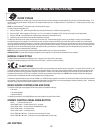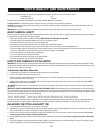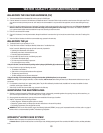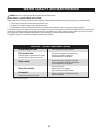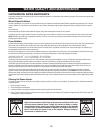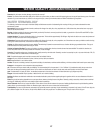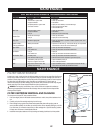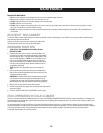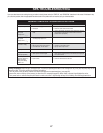
5. Carefully loosen the long Kynar
®
tubing to the bottom of the ozonator. A liquid substance may be found inside the tubing. If a liquid substance is present, BE
CERTAIN NOT TO COME INTO CONTACT WITH THE LIQUID (SEE WARNING ON PREVIOUS PAGE).
6. Place the end of the tubing into the vinegar, making certain that the end of the tubing sits at the bottom of the container.
7. Reconnect power to the spa.
8. Run the spa until all 16 ounces of the vinegar are gone. This should allow an ample flow of vinegar to be run through the injector and clear the blockage.
9. Disconnect power to the spa.
10. Remove the empty cup or bucket.
11. Reinstall the tubing to the bottom of the ozonator.
12. Plug the ozonator into the control box.
13. Close the equipment compartment door.
14. Reconnect power to the spa.
DOS AND DON’TS
• DON’T use swimming pool (muriatic) acid to lower pH.
• DON’T splash pH increaser additives on the siding.
• DON’T misuse Compressed Sanitizers.
The use of bromine sticks or tablets in floaters, which may become entrapped in a lounge or cooling seat (or sink to the spa floor), have been known to cause
discoloration of or surface distress to a spa’s shell.
• DON’T use a floater type sanitization system as a low or no maintenance solution to your spa maintenance program.
The spa shell can easily withstand the effects of a properly administered sanitizer. Floating dispensers can become trapped in one area and cause an over-sanitization
(or chemical burn) of that particular area.
If the dispenser setting is too high, the high concentration can discolor the spa shell and damage the underside of the cover.
Automatic floating dispensers have a tendency to either over-brominate or under-brominate as the rate of erosion varies greatly. Damage to the spa and cover can occur
very quickly.
WARNING: Watkins
®
Manufacturing Corporation does not recommend the use of any floating chemical dispenser. Damage to the spa shell or components caused
by a floating chemical dispenser is specifically not covered under the terms of the limited warranty.
• DON’T use a sanitizer which is not designed for spas.
• DON’T use household bleach (liquid sodium hypochlorite).
• DON’T broadcast or sprinkle the chemicals onto the water surface. This method may cause chemically-induced spa surface blistering (chemical abuse).
• DO add all chemicals slowly into the filter compartment with the jet pump operating for ten minutes.
• DO use special care if using baking soda to clean either the interior or exterior plastic surfaces.
• DO use only a granular form of sanitizer (chlorine).
COMMON WATER CHEMISTRY QUESTIONS
Question: Why is the use a floater not recommended to sanitize my spa water?
Answer: Watkins
®
Manufacturing Corporation does not recommend the use of a floater for three reasons:
1. The floater is unable to control the rate at which the sanitizer is dissolved into the water. When a floater is first placed in a spa, the sanitizer level can be extremely
high. High sanitizer levels can chemically burn or discolor the spa’s shell or the underside of the cover. Then, after a period of time, the sanitizer level dispensed by
the floater will fall to near zero. A low sanitizer level will allow viruses, bacteria or algae to grow.
2. Floaters tend to stay in one area of the spa most of the time (usually over the cool down seat), causing this area to be exposed to extreme sanitizer levels.
3. The floater may allow pieces of the highly concentrated sanitizer to fall out and settle on the floor or seat of the spa shell. These pieces of sanitizer will chemically
burn (blister) the spa shell. Although your spa shell is specifically designed to resist the effects of spa chemicals, no spa surface can withstand this type of highly
concentrated chemical. Remember, chemical abuse is specifically not covered under the terms of the warranty.
Question: When I open my spa, I smell chlorine. How do I get rid of this smell?
Answer: There are two types of chlorine in your spa. The first is the Free Available Chlorine, which is the chlorine available to sanitize your spa. This free Available
Chlorine does not have an odor. The second is Chloramine, which is residue from chlorine already expended. Chloramines have a strong chlorine odor. The smell from
Chloramines can be eliminated by “shocking” the water. If you smell chlorine in the water, your spa is reminding you to add a shock treatment.
Question: Why can’t I fill my spa with soft water?
Answer: Soft water is essentially the same as regular water except that most or all of the calcium has been replaced by sodium. Soft water may be corrosive to the
heater and other components. Replacement of spa components damaged by soft water is extremely expensive.
Question: I am trying to reduce the number of chemicals to which my family is exposed. Do I really need to use so many chemicals and in such large amounts?
Answer: While over-exposure to any chemical can be unhealthful, many low levels of chemicals are effective and beneficial. In the case of spa water, the chemicals
recommended in the Spa Water Maintenance program are needed to protect the user from water-borne pathogens (disease-causing microbes) and to prevent corrosion
of spa components.
WATER QUALITY AND MAINTENANCE
20



